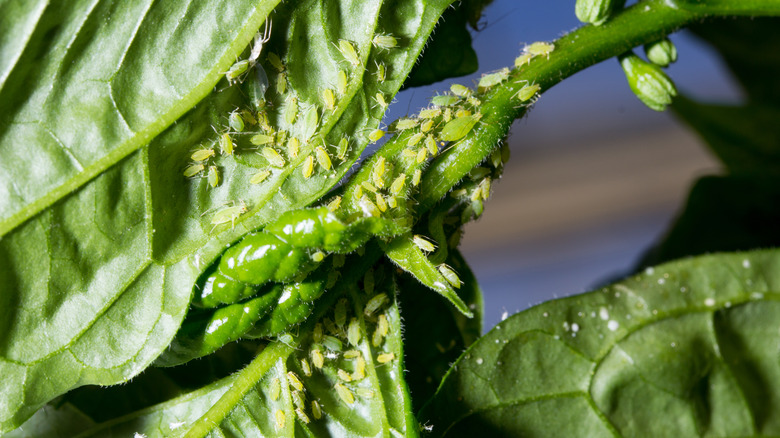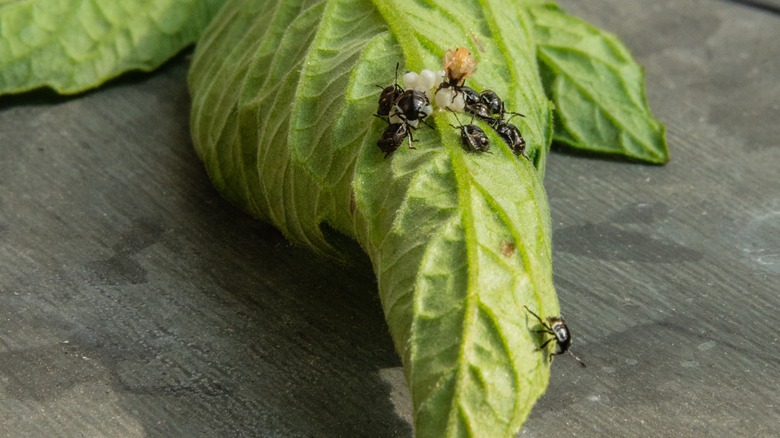Crisp, crunchy, sweet, and spicy, peppers are one of the most popular plants to grow in an edible garden. These vegetables tend to be pretty hearty, heat-tolerant, and low maintenance, making them one of the best plants to grow for beginner gardeners. Another advantage of spicy peppers specifically is that they’re generally safe from deer, squirrels, and other garden critters due to capsaicin, the compound that gives them their burn. However, humans aren’t the only ones who can tolerate and enjoy snacking on spicy peppers, as there are still a number of pests who will chow down on these plants whenever given the opportunity. They also won’t hesitate to take a bite out of bell and sweet varieties. Aphids, armyworms, leafhoppers and more threaten to destroy your harvest, weaken the plants, and spread diseases throughout your garden.
Some of these insects could be hiding right under your roots, just waiting for their moment in the sun. Whether you’ve just started your first garden or are planting peppers for the fifth year in a row, watch out for these 15 pests that hungrily attack your pepper plants. Also discover how to effectively rid your garden of them once and for all.
1. Aphids (Aphidoidea)

There are many types of aphids, but green peach aphids (Myzus persicae) tend to be the prime suspects when it comes to pepper gardens. Aphids can be identified by their small yellow-green bodies, and they tend to cluster together underneath leaves and stems. They sap hydration and nutrients from the plant, causing it to wilt. You can manage aphids by spraying them off with water, but a better long-term solution is to encourage beneficial predators like ladybugs to come close. To lure them in, plant flowers and herbs that contain lots of pollen like marigolds, fennel, and dill.
2. Thrips (Thysanoptera)
Another tiny bug that’s easy to miss, thrips tend to congregate on the leaves or flowers of pepper plants. Like aphids, they suck nutrients from the plant and cause it to dry up, shrivel, and eventually even die. Thrips also spread viruses like tomato spotted wilt virus between plants. Reflective mulch, insecticides, and sticky traps can help to prevent and deter thrips, but once they’ve bitten your plants, the virus has likely already taken hold. Washing with water will knock away thrips but won’t reverse the viral damage, so the best way to protect your peppers is to keep these insects away before they cause any harm.
3. Whiteflies (Aleyrodidae)
Tomasz Klejdysz/Shutterstock
Whiteflies drain nutrients from the plant, but they also leave behind a sticky excrement called honeydew. This honeydew creates the perfect substrate for mold and mildew to take hold. When this happens, the moldy growth can inhibit the plant’s ability to absorb sunlight, causing it to wilt and die. Adult whiteflies can be repelled by reflective mulch, and their numbers can be controlled by washing away eggs with water. You can also encourage parasitic wasps, predators to whiteflies, to visit your yard by adding Queen Anne’s lace, fennel, dill, and cilantro to your garden.
4. Cucumber beetles (Diabrotica undecimpunctata)
Erikagar/Getty Images
There are many different kinds of cucumber beetles, usually recognizable by their yellow bodies with black spots or stripes. These insects will chew through the leaves of your pepper plants, especially young and tender seedlings. Cucumber beetles are especially annoying pests because they spread disease to plants and lay their eggs underground, allowing larvae to feed on the roots before you can even spot them. To keep cucumber beetles out, hand-pick and destroy any insects you see, apply reflective mulch, place traps around your garden, and invite predators like ladybugs to dine on the larvae. You could also release beneficial nematodes in the area.
5. Armyworms (Spodoptera)
Kiran Nagare/Getty Images
Fall and beet armyworms are large green and brown caterpillars that eventually become moths but will happily munch on your peppers in the meantime. Hand-picking and destroying the worms will help, as will attracting natural predators like parasitic wasps into your garden. You can also introduce beneficial nematodes and entomopathogenic fungi to kill the caterpillars. If you choose to use an insecticide, apply it in the morning or afternoon when armyworms are most active.
6. Corn borers (Ostrinia nubilalis)
Tomasz Klejdysz/Shutterstock
While corn borers love corn (as their name suggests), they’ll also attack peppers when they’re hungry. Sweeter varieties like bell peppers and banana peppers are more susceptible to corn borers, but they may dig into your spicy varieties, too. These pests are some of the most destructive, quickly destroying leaves and even chewing into the peppers themselves. It’s not uncommon to cut open a bell pepper and find one of these nasty larvae hiding inside. The best way to combat corn borers is to use a Bacillus thuringiensis spray, a natural bacteria that stops borers from feeding.
7. Cutworms (Noctuidae)

KanphotoSS/Shutterstock
Cutworms are larvae from moths in the Noctuidae family with a thick, grub-like appearance. These pests hide beneath the soil in your garden, emerging at night to feed on the pepper plants. The worst part about cutworms is that they tend to attack the roots, stalk, and stem, felling the plants very quickly. Hand-picking them off at night, using a Bacillus thuringiensis spray, and releasing beneficial nematodes are all effective methods of removing cutworms. However, it’s also crucial to take preventative measures, including placing slug collars around the plants. You can also toss these chunky bugs to your chickens and ducks.
8. Corn earworms (Helicoverpa zea)

Maurien trabbold/Shutterstock
Corn earworms look similar to armyworms and corn borers, with pale brownish bodies, stripes down their back, and an orangish head. It can be easy to confuse these different species, but luckily, the treatment for corn earworms, armyworms, and corn borers on pepper plants is relatively the same. Insecticides including Sevin, permethrin, and spinosad are effective against corn earworms and should be sprayed before eggs hatch. Be cautious if you’re plucking the worms by hand, as corn earworms can bite when handled.
9. Hornworms (Manduca quinquemaculata)

I Wayan Sumatika/Shutterstock
Hornworms are one of the largest garden pests that feast on pepper plants, so they’re hard to miss. These insects have bright green or yellow bodies and can grow up to 4 inches long. The beefy garden pests have a horn near their rump that they use to defend themselves against predators, so birds and toads may have a trickier time keeping populations down. However, parasitic wasps can still be very effective against hornworms, laying their eggs inside the worms so that they grow and kill their host. Insecticides like Sevin will also kill the hornworms.
10. Spider mites (Tetranychidae)

Jess311/Getty Images
Spider mites are tiny red mites that spin delicate webs around your pepper plants, particularly the leaves and stems. Like aphids and thrips, spider mites will suck moisture from the leaves and cause your plants to yellow, curl, shrivel, and even drop their fruits. These insects are especially bad news for pepper plants growing in hot, dry climates. Lacewings and ladybugs can help to control the pests, as can spraying the leaves with water, and insecticides usually aren’t necessary.
11. Flea beetles (Alticini)

Katarzyna Kornecka/Shutterstock
Flea beetles will chew neat little holes straight through your pepper plant’s leaves, weakening them and leaving them vulnerable to disease. When larvae emerge from underground in the spring, they’ll feed on the roots of plants too, especially tender seedlings. Planting radishes as an offering may lure the beetles away from your prized pepper plants, where you can then spray an insecticide to kill them. Remove any debris from the garden in winter so that flea beetles won’t have anywhere to hide.
12. Potato leafhoppers (Cicadellidae)

Tomasz Klejdysz/Shutterstock
Adult potato leafhoppers are particularly destructive because they have the ability to fly between plants, wreaking havoc and transmitting diseases. If you have leafhoppers in your garden, you’ll likely notice white stippling and yellowing of the edges of the leaves where they have fed and left behind a toxic saliva. Attracting natural predators to your yard will help tremendously, but you can also sprinkle diatomaceous earth around your plants to prevent leafhoppers from feeding.
13. Leaf miners (Agromyzidae)

Shakeel Sha/Getty Images
Leaf miners are larval forms of Pegomya hyoscyami or Liromyza sativae flies, which lay their eggs in leaves. When the eggs hatch, the little larvae burrow under the epidermis of the leaf, creating pale squiggly trails under the surface. The larvae are tiny, but their damage is hard to miss! Pesticides and net covers can be used to prevent adult flies from accessing your garden, but once they are inside the leaves, there isn’t much you can do to remove them. Luckily, however, they should only affect the leaves and not the fruit. After harvest, thoroughly clean out your garden to destroy any pupae in the soil.
14. Pepper weevils (Anthonomus eugenii)

fit0arechiga10 / Instagram
Most other pests on this list would prefer sweeter vegetables over your pepper plants, but Anthonomus eugenii loves to chow down on plants in the Capsicum family. An infestation of pepper weevils can cause buds and fruits to shrivel and drop from the plants, but even small bites can allow fungi to take up residence inside the fruits. Weevil parasitoid wasps are one of the only effective means of naturally-controlling these pests, as insecticides aren’t always effective. To keep pepper weevils from overwhelming your garden, destroy any rotten or fallen fruits to disrupt their life cycle.
15. Pepper maggots (Zonosemata electa)

Utkarsh Patil/Getty Images
Like pepper weevils, pepper maggots have a particular affinity for nightshade plants, including tomatoes, eggplants, and peppers. Zonosemata electa is the fly responsible for pepper maggot infestations. You may not know you’re dealing with this pest until you cut open the fruit and spy them hidden in the seedhead. If the maggots mature, they’ll damage the fruit as they crawl out, allowing bacteria to swoop in and rot the pepper. To prevent pepper maggots from ruining your harvest, target adult flies with insecticides, sticky traps, or fruit fly traps.


